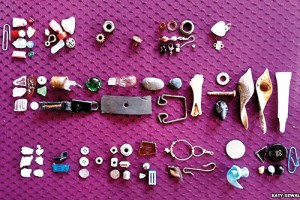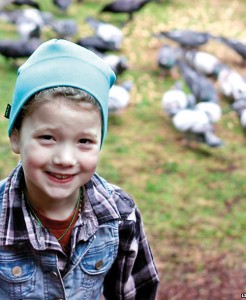Sunday Times 2
The girl who gets gifts from birds
Lots of people love the birds in their garden, but it’s rare for that affection to be reciprocated. One young girl in Seattle is luckier than most. She feeds the crows in her garden – and they bring her gifts in return.
Eight-year-old Gabi Mann sets a bead storage container on the dining room table, and clicks the lid open. This is her most precious collection.
“You may take a few close looks,” she says, “but don’t touch.” It’s a warning she’s most likely practised on her younger brother. She laughs after saying it though. She is happy for the audience.

The crows clear the feeder of peanuts, and leave shiny trinkets on the empty tray; an earring, a hinge, a polished rock (BBC)
Inside the box are rows of small objects in clear plastic bags. One label reads: “Black table by feeder. 2:30 p.m. 09 Nov 2014.” Inside is a broken light bulb. Another bag contains small pieces of brown glass worn smooth by the sea. “Beer coloured glass,” as Gabi describes it.
Each item is individually wrapped and categorised. Gabi pulls a black zip out of a labelled bag and holds it up. “We keep it in as good condition as we can,” she says, before explaining this object is one of her favourites.
There’s a miniature silver ball, a black button, a blue paper clip, a yellow bead, a faded black piece of foam, a blue Lego piece, and the list goes on. Many of them are scuffed and dirty. It is an odd assortment of objects for a little girl to treasure, but to Gabi these things

Eight-year-old Gabi Mann feeds the crows in her garden - and they bring her gifts in return (BBC)
are more valuable than gold.
She didn’t gather this collection. Each item was a gift – given to her by crows.
She holds up a pearl coloured heart. It is her most-prized present. “It’s showing me how much they love me.”
Gabi’s relationship with the neighbourhood crows began accidentally in 2011. She was four years old, and prone to dropping food. She’d get out of the car, and a chicken nugget would tumble off her lap. A crow would rush in to recover it. Soon, the crows were watching for her, hoping for another bite.
As she got older, she rewarded their attention, by sharing her packed lunch on the way to the bus stop. Her brother joined in. Soon, crows were lining up in the afternoon to greet Gabi’s bus, hoping for another feeding session.
Gabi’s mother Lisa didn’t mind that crows consumed most of the school lunches she packed. “I like that they love the animals and are willing to share,” she says, while admitting she never noticed crows until her daughter took an interest in them. “It was a kind of transformation. I never thought about birds.”
In 2013, Gabi and Lisa started offering food as a daily ritual, rather than dropping scraps from time to time.
Each morning, they fill the backyard birdbath with fresh water and cover bird-feeder platforms with peanuts. Gabi throws handfuls of dog food into the grass. As they work, crows assemble on the telephone lines, calling loudly to them.
It was after they adopted this routine that the gifts started appearing.
The crows would clear the feeder of peanuts, and leave shiny trinkets on the empty tray; an earring, a hinge, a polished rock. There wasn’t a pattern. Gifts showed up sporadically – anything shiny and small enough to fit in a crow’s mouth.
One time it was a tiny piece of metal with the word “best” printed on it. “I don’t know if they still have the part that says ‘friend’,” Gabi laughs, amused by the thought of a crow wearing a matching necklace.
When you see Gabi’s collection, it’s hard not to wish for gift-giving crows of your own.
“If you want to form a bond with a crow, be consistent in rewarding them,” advises John Marzluff, professor of wildlife science at the University of Washington. He specialises in birds, particularly crows and ravens.
What food is best? “A few peanuts in the shell,” he says. “It’s a high-energy food… and it makes noise when you throw it on the ground, so they hear it and they quickly habituate to your routine.”
Marzluff, and his colleague Mark Miller, did a study of crows and the people who feed them. They found that crows and people form a very personal relationship. “There’s definitely a two-way communication going on there,” Marzluff says. “They understand each other’s signals.”
The birds communicate by how they fly, how close they walk, and where they sit. The human learns their language and the crows learn their feeder’s patterns and posture. They start to know and trust each other. Sometimes a crow leaves a gift.
But crow gifts are not guaranteed. “I can’t say they always will (give presents),” Marzluff admits, having never received any gifts personally, “but I have seen an awful lot of things crows have brought people.”
Not all crows deliver shiny objects either. Sometimes they give the kind of presents “they would give to their mate”, says Marzluff. “Courtship feeding, for example. So some people, their presents are dead baby birds that the crow brings in.”
Gabi has been given some icky objects. Her mother threw out a rotting crab claw, for example.
Gabi points out a heavily rusted screw she prefers not to touch. It’s labelled “Third Favorite.” Asking her why an untouchable object is in the favourites, she answers, “You don’t’ see a crow carrying around a screw that much. Unless it’s trying to build its house.”
Lisa, Gabi’s mom, regularly photographs the crows and charts their behaviour and interactions. Her most amazing gift came just a few weeks ago, when she lost a lens cap in a nearby alley while photographing a bald eagle as it circled over the neighbourhood.
She didn’t even have to look for it. It was sitting on the edge of the birdbath.
Had the crows returned it? Lisa logged on to her computer and pulled up their bird-cam. There was the crow she suspected. “You can see it bringing it into the yard. Walks it to the birdbath and actually spends time rinsing this lens cap.”
“I’m sure that it was intentional,” she smiles. “They watch us all the time. I’m sure they knew I dropped it. I’m sure they decided they wanted to return it.”
(Courtesy BBC)

